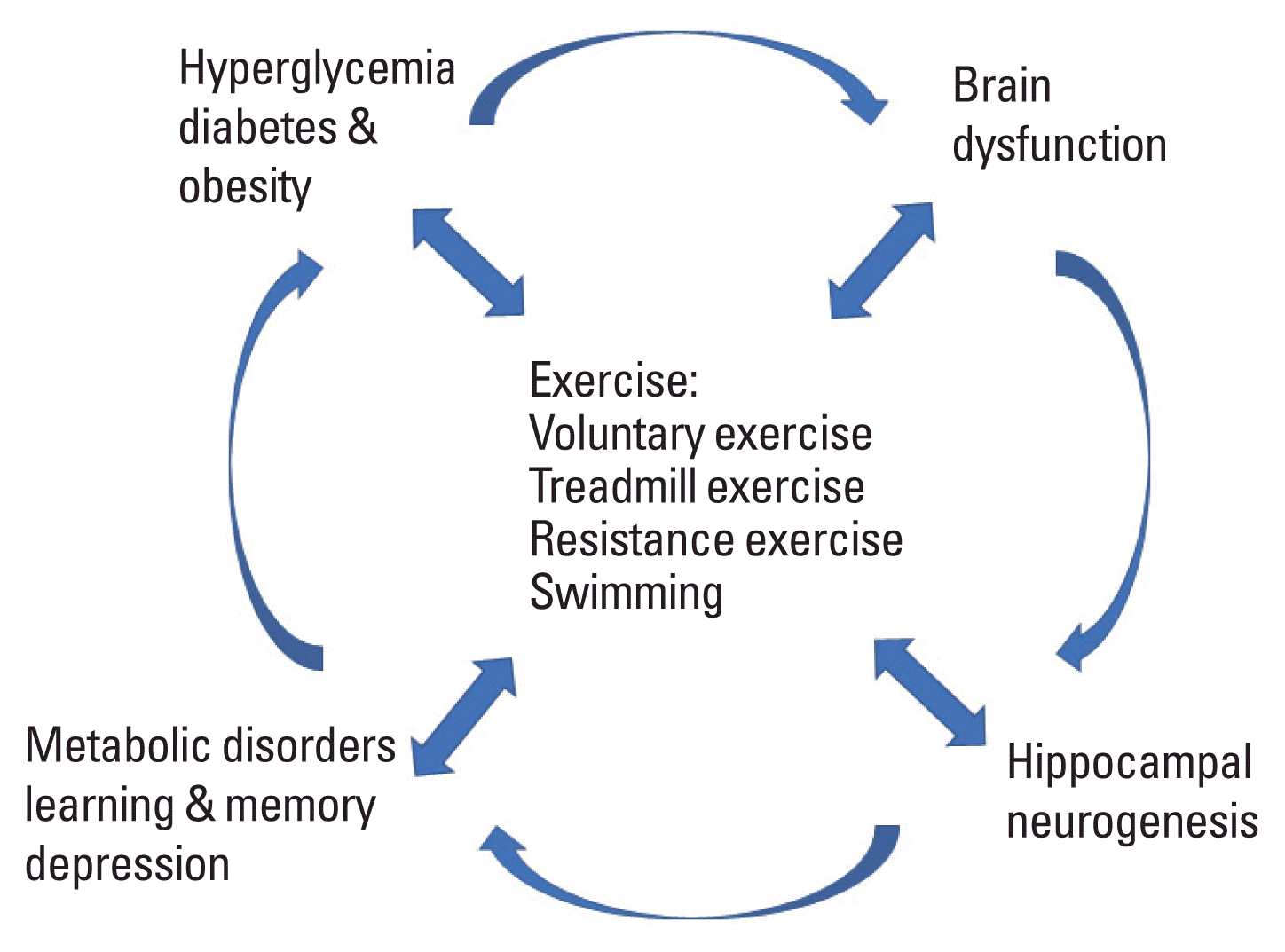Impact of exercise on hippocampal neurogenesis in hyperglycemic diabetes
Article information
Abstract
Hyperglycemic diabetes is a chronic metabolic disorder characterized by high level of plasma glucose. Numerous studies have shown that hy-perglycemic diabetes leads to brain dysfunction including cognitive im-pairment and emotional disorders. This study evaluated the impact of exercise on brain dysfunction, hippocampal neurogenesis, and cogni-tive impairment in hyperglycemic diabetes. The present study suggests that exercise improves hyperglycemic control and prevents decline of cognition through increasing hippocampal neurogenesis. Understanding the mechanism of exercise for hippocampal neurogenesis can lead to the development of therapeutic strategies for metabolic disorders.
INTRODUCTION
Hyperglycemic diabetes can be defined as a chronic metabolic disorder characterized by hyperglycemia. Impaired glucose metabolism can be resulted from inappropriate insulin secretion, insulin resistance, and acute stress. Diabetes leads to severe complications affecting different organs including the heart, kidney, eye, and brain. The effects of metabolic disorders such as diabetes and obesity have been shown on the central nervous system (Ji et al., 2013; Qizilbash et al., 2015). Diabetic brain complications are associated with cognitive decline and depression. Diabetes patients have increased vulnerability to cognitive impairment (Ho et al., 2013).
Exercise can promote energy metabolism, reduce insulin resistance, and control glucose homeostasis. Exercise is considered an effective strategy to reduce glucose level and diabetes symptom. Exercise-induced improvement in learning and memory can be considered as exercise-dependent neural plasticity and hippocampal neurogenesis (Baek, 2016). However, we have not fully understood the effects of exercise on neurogenesis and cognitive function in hyperglycemic diabetes.
EXERCISE AND BRAIN DYSFUNCTION IN HYPERGLYCEMIC DIABETES
Hyperglycemic diabetes affects the brain function. Blockade of brain glucose transport or astrocytic glucose metabolism inhibits learning and memory (McNay et al., 2000). Impaired brain glucose homeostasis interferes with learning process and memory consolidation (Duarte, 2015). Insulin receptors are generally expressed in the brain, especially in the hippocampus. Impaired insulin signaling is believed to be associated with increasing Tau phosphorylation by reducing phosphorylation of protein kinase B (Akt) and glycogen synthase kinase 3 (Schubert et al., 2004). Ddiabetes changes integrity of a brain region mediating learning and memory, inducing defect of long-term potential in the hippocampus (Trudeau, 2004). Impaired hippocampal-dependent spatial learning and memory observed in hyperglycemia-induced diabetic animals (Kim et al., 2014; Kim et al., 2016).
Normalization of brain energy metabolism is a crucial factor to counteract central insulin sensitivity and synaptic plasticity associated with type-2 diabetes (Agrawal et al., 2014). Treadmill exercise alleviates memory loss in the streptozotocin (STZ)-induced diabetic rats (Kim et al., 2016). Exercise protects central nervous system injury and improves learning ability and memory function (Lee et al., 2018; Sim, 2014). Aerobic exercise promotes the expression of synaptic plasticity-associated proteins in the hippocampus of diabetic rats (Li et al., 2019).
EXERCISE AND HIPPOCAMPAL NEUROGENESIS IN HYPERGLYCEMIC DIABETES
Diabetes negatively affects the morphological integrity of the hippocampus and reduces hippocampal neurogenesis (Ho et al., 2013). Hyperglycemic diabetes reduces expression of dendritic spines and synaptic proteins and increases markers of apoptosis in the hippocampus of the brain (Ho et al., 2013). STZ-induced hyperglycemic diabetes suppresses hippocampal neurogenesis in rodents (Kim et al., 2016). Decreased hippocampal neurogenesis and neuroplasticity is associated with cognitive impairment and depressive behavior (Baek, 2016).
Regular exercise alleviated memory impairment through enhancing cell proliferation in the hippocampus in hyperglycemic diabetes (Kim et al., 2014). Treadmill exercise alleviates Alzheimer disease-associated memory loss by increasing neurogenesis through activating Wnt signaling pathway in the diabetic rats (Kim et al., 2016). Physical exercise increases the number of neuronal and non-neuronal cortical cells and hippocampal neuronal cells in adolescent rats (Victorino et al., 2017). Neurogenesis can be an important contributor to improving learning and memory through exercise (Baek, 2016; Li et al., 2019).
EXERCISE AND COGNITIVE IMPAIRMENT IN HYPERGLYCEMIC DIABETES
In a type 2 analogous model such as the Zucker diabetic rat, hyperglycemia was significantly increased and cognitive function was decreased compared to the nondiabetic Zucker rat (Yi et al., 2009). Diabetes mellitus is considered as a risk factor for Alzheimer disease (Baek et al., 2016). Short-term memory and spatial learning ability were deteriorated by induction of diabetes (Kim et al., 2016).
In addition to improved glycemic control, exercise could also contribute to increased hippocampal neuronal production by enhancing brain-derived neurotrophic factor, insulin-like growth factor-1 and vascular endothelial growth factor (van Praag, 2008). Exercise can improve cognitive function in dementia patients and reduce the risk of dementia (McDonnell et al., 2011). People with hyperglycemic diabetes who participate in exercise programs may improve glucose metabolism and have a positive effect on mood (de Groot et al., 2012). Treadmill running improved spatial memory in Morris water maze and in 8-arms maze test through activation brain-derived neurotrophic factor activation (Heo et al., 2014; Seo et al., 2013).
CONCLUSIONS
This study showed evidence of the effect of exercise to improve cognition by increasing neurogenesis (Fig. 1). The beneficial role of exercise may be a valuable treatment to improve brain cell dysfunction in hyperglycemic diabetes by increasing neuronal cell proliferation. Understanding the mechanism of exercise for hippocampal neurogenesis can lead to the development of therapeutic strategies for metabolic disorders.
Notes
CONFLICT OF INTEREST
No potential conflict of interest relevant to this article was reported.
ACKNOWLEDGMENTS
This work was supported by 2018 Sangmyung University Research Foundation of Korea.

